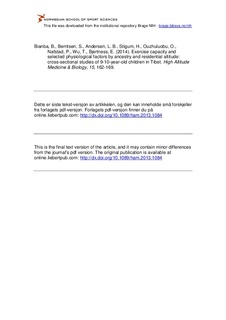| dc.contributor.author | Bianba, Bianba | |
| dc.contributor.author | Berntsen, Sveinung | |
| dc.contributor.author | Andersen, Lars Bo | |
| dc.contributor.author | Stigum, Hein | |
| dc.contributor.author | Ouzhuluobu | |
| dc.contributor.author | Nafstad, Per | |
| dc.contributor.author | Wu, Tianyi | |
| dc.contributor.author | Bjertness, Espen | |
| dc.date.accessioned | 2015-05-22T12:39:32Z | |
| dc.date.available | 2015-05-22T12:39:32Z | |
| dc.date.issued | 2014-05-16 | |
| dc.identifier.citation | High Altitude Medicine & Biology. 2014, 15, 162-169 | nb_NO |
| dc.identifier.uri | http://hdl.handle.net/11250/283970 | |
| dc.description | I Brage finner du siste tekst-versjon av artikkelen, og den kan inneholde ubetydelige forskjeller fra forlagets pdf-versjon. Forlagets pdf-versjon finner du på online.liebertpub.com: http://dx.doi.org/10.1089/ham.2013.1084 / In Brage you'll find the final text version of the article, and it may contain insignificant differences from the journal's pdf version. The original publication is available at online.liebertpub.com: http://dx.doi.org/10.1089/ham.2013.1084 | nb_NO |
| dc.description.abstract | Several physiological compensatory mechanisms have enabled Tibetans to live and work at high altitude, including increased ventilation and pulmonary diffusion capacity, both of which serve to increase oxygen transport in the blood. The aim of the present study was to compare exercise capacity (maximal power output) and selected physiological factors (arterial oxygen saturation and heart rate at rest and during maximal exercise, resting hemoglobin concentration, and forced vital capacity) in groups of native Tibetan children living at different residential altitudes (3700 vs. 4300 m above sea level) and across ancestry (native Tibetan vs. Han Chinese children living at the same altitude of 3700 m).
Methods: A total of 430 9–10-year-old native Tibetan children from Tingri (4300 m) and 406 native Tibetan- and 406 Han Chinese immigrants (77% lowland-born and 33% highland-born) from Lhasa (3700 m) participated in two cross-sectional studies. The maximal power output (Wmax) was assessed using an ergometer cycle.
Results: Lhasa Tibetan children had a 20% higher maximal power output (watts/kg) than Tingri Tibetan and 4% higher than Lhasa Han Chinese. Maximal heart rate, arterial oxygen saturation at rest, lung volume, and arterial oxygen saturation were significantly associated with exercise capacity at a given altitude, but could not fully account for the differences in exercise capacity observed between ancestry groups or altitudes.
Conclusions: The superior exercise capacity in native Tibetans vs. Han Chinese may reflect a better adaptation to life at high altitude. Tibetans at the lower residential altitude of 3700 m demonstrated a better exercise capacity than residents at a higher altitude of 4300 m when measured at their respective residential altitudes. Such altitude- or ancestry-related difference could not be fully attributed to the physiological factors measured. | nb_NO |
| dc.language.iso | eng | nb_NO |
| dc.publisher | Mary Ann Liebert Publishers | nb_NO |
| dc.subject | high altitude | nb_NO |
| dc.subject | adaptation | nb_NO |
| dc.subject | maximal exercise | nb_NO |
| dc.subject | arterial oxygen saturation | nb_NO |
| dc.subject | hemoglobin | nb_NO |
| dc.title | Exercise capacity and selected physiological factors by ancestry and residential altitude: cross-sectional studies of 9-10-year-old children in Tibet | nb_NO |
| dc.type | Journal article | nb_NO |
| dc.type | Peer reviewed | nb_NO |
| dc.subject.nsi | VDP::Medical disciplines: 700 | nb_NO |
| dc.source.journal | High Altitude Medicine & Biology | nb_NO |
| dc.description.localcode | Seksjon for idretssmedisinske fag / Department of Sports Medicine | nb_NO |
